
Papilio paris, the Paris peacock swallowtail, is a species of swallowtail butterfly found in the Indian subcontinent and southeast Asia.

Papilio alcmenor, the redbreast, is a species of swallowtail butterfly found in South Asia.
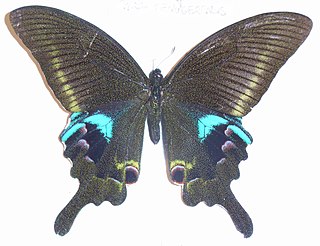
Papilio arcturus, the blue peacock, is a species of swallowtail butterfly found in the Indian subcontinent.

Papilio bootes, the tailed redbreast, is a swallowtail butterfly found in Asia. Within their wide distribution about four population variants have been named as subspecies. They have been placed within the Menelaides clade by a 2015 phylogenetics study.

Papilio castor, the common raven, is a species of swallowtail butterfly found in Cambodia and South Asia.

Papilio prexaspes, the blue Helen, is a swallowtail butterfly found in Southeast Asia. The race found in the Andaman and Nicobar Islands, Papilio prexaspes andamanicus, is also known as the Andaman Helen.
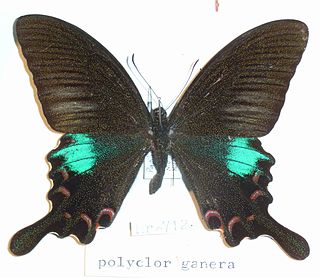
Papilio polyctor, the common peacock or indian peacock or mahaonovaya indian butterfly with emerald- is a swallowtail butterfly found in the Indian subcontinent. It is found in the Himalayas and parts of India from the foothills to 7,000 feet (2,100 m) between March and October. It has distinct dry- and wet-season forms. The butterfly frequents Buddleia flowers. Its food plant is Zanthoxylum alatum of the family Rutaceae. Papilio polyctor has three subspecies, consisting of Papilio polyctor significans, Papilio polyctor stockleyi, and Papilio polyctor xiei.

Papilio protenor, the spangle, is a butterfly found in India belonging to the swallowtail family.
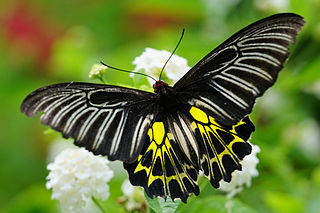
Troides aeacus, the golden birdwing, is a large tropical butterfly belonging to the swallowtail family, Papilionidae.

Meandrusa sciron, the brown gorgon, is a species of swallowtail butterfly found in parts of South Asia and Southeast Asia. It belongs to the hooked swallowtails genus, Meandrusa, of the family Papilionidae. The brown gorgon is found in India from Sikkim to Assam and north Burma and is not considered to be threatened. Though not uncommon, it is protected under Indian law under the name gyas.

Papilio clytia, the common mime, is a swallowtail butterfly found in south and southeast Asia. The butterfly belongs to the subgenus Chilasa, the black-bodied swallowtails. It serves as an excellent example of a Batesian mimic among the Indian butterflies.

Papilio (Chilasa) epycides, the lesser mime, is a swallowtail butterfly found in India and parts of South-East Asia. The butterfly belongs to the mime (Chilasa) subgenus or the black-bodied swallowtails. It is a mimic of a common Indian Danainae, the glassy tiger butterfly.

Papilio (Chilasa) paradoxa, the great blue mime, is a swallowtail butterfly found in India and parts of South-East Asia. The butterfly belongs to the mime subgenus, Chilasa, of the genus Papilio. It is an excellent mimic of different species of Euploea.

Papilio (Chilasa) slateri, the blue striped mime, is a swallowtail butterfly found across south and south-east Asia. The butterfly belongs to the mime subgenus, Chilasa, of the genus Papilio, the black-bodied swallowtails. The nominate subspecies is found in India and is also called the brown mime. It is a good example of mimicry among Indian butterflies.

Graphium macareus, the lesser zebra, is a relatively common and not threatened species of swallowtail butterfly found in Southeast Asia. It is also found in parts of India including Assam and Sikkim.

Graphium xenocles, the great zebra, is a swallowtail butterfly found in Southeast Asia which is common and not threatened.

Papilio mayo, the Andaman Mormon, is a species of swallowtail butterfly that is endemic to the Andamans in the Bay of Bengal. It is a species that is protected by Indian Law. The scientific name honours Richard Bourke, 6th Earl of Mayo, who was assassinated at Port Blair the year before the butterfly was discovered.
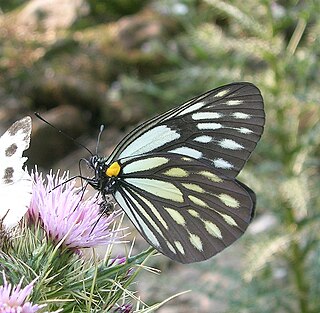
Aporia agathon, the great blackvein, is a mid-sized butterfly of the family Pieridae, that is, the yellows and whites, which is found in Nepal, India, China and Southeast Asia.

Cepora nadina, the lesser gull, is a small to medium-sized butterfly of the family Pieridae, that is, the yellows and whites. The species was first described by Hippolyte Lucas in 1852. It is native to Sri Lanka, India, Myanmar, Hainan, and southeast Asia.
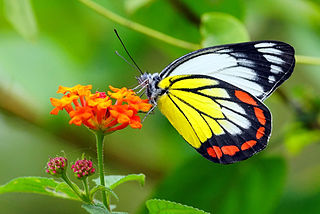
Delias hyparete, the painted Jezebel, is a medium-sized butterfly of the family Pieridae, found in South Asia and Southeast Asia.
























